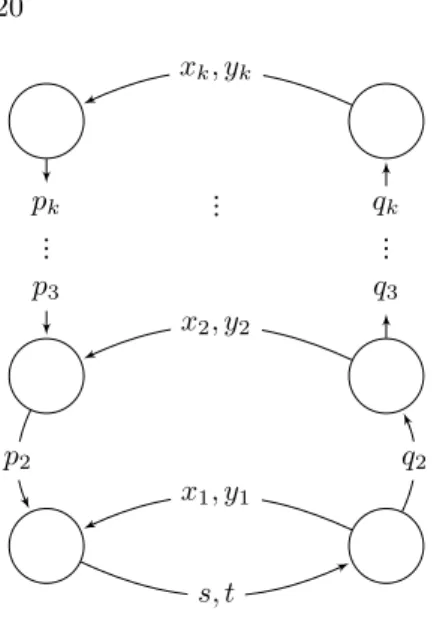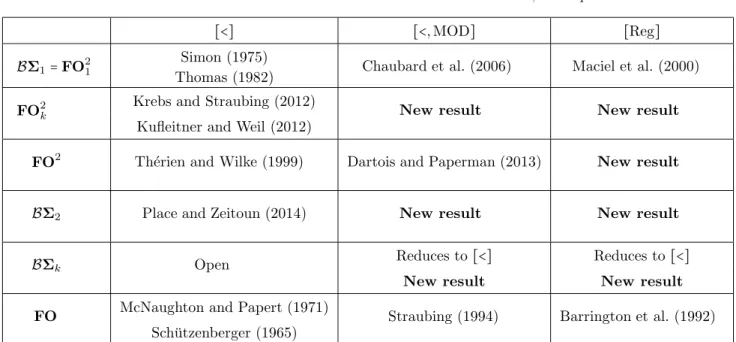We investigate the decidability of the definability problem for fragments of first-order logic over finite words enriched with modular predicates. For two-variable fragments, we also consider the case of a signature containing only order and modular predicates. The main components of the proofs are the syntactic transformations of the first-order formulas as well as the algebraic framework of finite categories.
As a consequence of this work, Straubing found that the decidability of the alternating hierarchy of first-order logic (BΣk) equipped with [<,+1] reduces to the decidability of the simpler [<]. Finally, the authors provided a characterization of first-order logic of two variables via the signature [<, MOD] (Dartois and Paperman, 2013). The main applications of our theorems are therefore hierarchies of permutations of quantifiers of first-order logic and its dual variables.
The decidability of each level reduces to the decidability of the corresponding level of the Straubing-Th'erien hierarchy (Straubing, 1985). We call the setAd=A×Zd the enriched alphabet ofA, and we denote byπd∶A∗d→A∗ the projection defined byπd(a, i)=afor each(a,i)∈Ad. The rest of the article is devoted to the problem of deciding one witness, given a language.
This figure does not include the decidability of the smaller fragments of FO equipped with modular predicates: FO[MOD](Theorem 6),FO[+1,MOD](Theorem 7),FO[=,MOD](Theorem 8) and FO[= ,+1,MOD](Theorem 9).

A derived category theorem
The following theorem is a well-known result which states that the membership of a category in gV reduces to the membership of Vis the variety is sufficiently expressive. In this section, we recall some well-known results that we will use in the rest of the article and give some intuitions about their meaning. We first give the definition of the derived category for particular languages and provide the delay theorem of Straubing (1985) as well as its improvement by Tilson (1987).
An n-derived category with respect to certain languages, of a regular language L, denoted by Dn(L), is the category Dn(ηL(A+)). We do not recall the definition of the crown product of the variety V with D, denoted by V∗D. However, since our only use of this product is given by the following theorem, the untrained reader may take the following theorem as a definition.
The proof of the following statement follows the proof of Theorem 3 using the adapted notion of an enriched alphabet. Let F[σ] be a fragment of logic equivalent to the variety V, and let L be a regular language with S as a syntactic semigroup. Following the previous paragraph, we give a definition of a derived category adapted to modular languages, which was largely inspired by the article by Chaubard et al.
Died-derived category of ϕ, denoted Cd(ϕ), is the category with Zd as set of objects, and the arrows from i to j are the elements m of M such that there exists a word u corresponding to ϕ(u) = m and i+ comply. ∣u∣ ≡ jmodd. The following lemma is a simple consequence of the definition which will be of some use. The derived category theorem was originally proved by Tilson (1987) for varieties of monoids and semigroups.
Let F[σ] be a logical fragment equivalent to a variety of monoidsV,La a regular language and a positive integer. Without giving details, this is due to the fact that some syntactic congruence elements of L can merge when they appear in some specific congruences, leading to the non-empty intersection of arrow images. In the following, we use the idea that for every pair of elements there exists a congruence that separates them according to the definition of syntactic congruence.
Using this characterization, we can prove that the language(aa)∗ab(bb)∗ whose stable monoid is in J does not satisfy Knast's equation since.
Finite rank
We say that a finite category C satisfies the equation (X, u=v) if ϕ̂(u)=ϕ̂(v) holds for any morphism ϕ∶X∗→C. A variety of monoids V is said to have rank ki if its global is defined by a set of bounded path equations with at most k nodes. Moreover, most known fragments of logic are equivalent to the finite-rank variety.
However, the question remains open in some cases, e.g. for the levels of the dot-depth hierarchy. For example, the variation of semilattice monoids is J1 = Jxy=yx, x2=xK, the variety DA =J(xy)ωx(xy)ω=(xy)ωK, the variation of aperiodic monoids A=Jxω=xω+1K . A recent algebraic description of the languages that can be defined by the formulas BΣ2k+1[<] was established in Krebs and Straubing (2012); Kufleitner and Weil (2012).
From the latter result we derive the following description of gVk, which gives a rank of at most 2k. Proof: First note that since the if condition is trivial, we only need to prove the only if implication. Now notice that if rank(V) = 1 then the variety is local and we know that we can restrict the stability index to congruence modulo.
The idea behind this is dati=θ(i)ifi before the gap appears enks−i=ds−θ(i)ifi appears after it. Then each arrow of E will either appear directly as it appears for Cks(L) if it does not cross the gap, and since the gap is large, we will be able to pump the arrows that cross it. If ∣u∣⩾s, then we know, by definition of the stability index, that for any positive integer ℓ there exists a worduℓ such thatℓs⩽∣uℓ∣<(ℓ+1)s, ∣u∣=∣uℓ∣ modsand u≡L uℓ.
Finally, the case where θ(i)=i and θ(j)=ds+j−ks cannot occur because it implies that i⩽iV and j>iV +s, and that ∣u∣=j −i>smodks, which contradicts the ∣u ∣0.

Infinitely testable case
For varieties of the form V∗D this also gives the decidability thanks to Proposition 27 and Corollary 5. Therefore L belongs to F[σ,+1,MOD] if and only if there exists d such that Ld belongs to F[σ ,+ 1]. Before proving this assertion, let us note that since a variety of semigroups is closed by division, this assertion terminates the proof.
If xy=0, then either xy does not have a well-formed square or xy is zero for π−1s (L). However, for a local variety V, which is not a group variety, the semigroup variety LV is local, as proved by Paperman (2014). Note now that Ss is the quotient of the product S and the syntactic semigroup Ks.
It can be noted that since Vis is not a variety of groups, it contains the semigroup U1={0,1} (endowed with multiplication of integers). Otherwise, e is the image of a well-formed factor u starting with a letter of the form (a, i) and ending with a letter of the form (a, j) with j+1≡imods. In this paper, we studied the determinability problem for logical fragments enriched with modular predicates.
We presented a generic approach that provides the ability to solve this problem in many cases, while the main applications are to alternation hierarchies of the first-order logic and its two variable counterpart. We prove that adding a finite set of modular predicates preserves decidability, given that the fragment is expressive enough. The second part, which we call the delay problem, consists in deciding which finite set of modular predicates to add to express a given regular language.
Although we were not able to solve this question for any given fragment, we were able to reduce this question, following some known results, to a decidability question on the global of a fragment, a variety of categories. The second case is when the fragment is expressive enough to handle the modular predicates. The main applications of these results are given in Figure 2, mainly at the levels of the quantifier-switching hierarchies, although this approach can be used on other fragments that satisfy the same hypotheses, such as the fragmentFO[+1].
The question of solving the addition of modular predicate in a general setting seems feasible, although the more natural question would be to solve the decidability of the semidirect product by MOD. While we avoided this characterization as it served no purpose in our approach, an aware reader could have noticed that Theorem 16 proves that the addition of modular predicates is algebraically equivalent to a semidirect product by the length-multiplicative variety of morphismsMOD .
